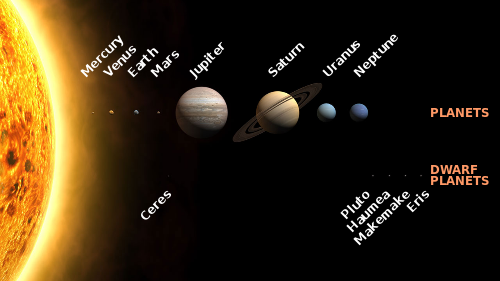
The radius of the solar system is about 100,000 AU, or 1.6 light year, or 0.5 parsecs. (1pc =3.26 ly)
AN OVERALL VIEW OF ASTRONOMY AND
THE UNIVERSE
A. ASTRONOMY AND SCIENCE
Astronomy: the study of the extraterrestrial bodies and related aspects of the physical universe.
Physical Universe: Everything that can be sensed, observed, or measured.
Science deals only with things that can be measured in some way.
Measurements lead to numbers (data) that quantify in some way, what we have observed.
Instruments enable us to
augment and extend our senses in order to make more objective
and precise measurements.
Data are studied to find
correlations and relationships among the numbers. The relationships
sought are to describe in
a logical and rational way what we have sensed or what we see
happening (phenomena).
If we succeed to find statements
that describe and predict what we observe in the physical
world or universe, we call
these descriptions the laws of nature or the laws of physics.
Laws of Physics: Approximate
descriptions of what is observed in the physical world.
They are anthropogenic inventions,
not discoveries. That is, the laws of physics do not exist
in any absolute sense.
They have been constituted by humans based on experiments and
observations..
The validity of any law is
its ability to describe the phenomena to which it is applicable and to
predict what will happen
for a given set of conditions and only for those conditions.
Using the laws of physics,
we construct models of the physical world that help us visualize the
laws and the structure of
things. E. G. the model of the atom, the model that light is a wave,
the model of the Galaxy,
or the model of the structure of the Earth.
B. THE HIERARCHICAL STRUCTURE OF THE UNIVERSE
Historically, our knowledge
of the universe has developed by making observations from the
Earth. These observations
were limited at first to what could be seen just by eye alone. This
revealed only the immediate
vicinity of the Earth.
For example, the Earth is
one of many planetary bodies that move in orbit around a star we
call the Sun.
Slowly, our understanding
of the universe grew outwards as technology developed. Today,
we recognize the following
hierarchical
structure in the universe:
1. The Solar System: A gravitationally bound system consisting of the Sun and all its satellites.
The diagram below is a schematic of the largest bodies in the Solar
System
(Courtesy of NASA)

The radius of the solar system is about 100,000 AU, or 1.6 light year,
or 0.5 parsecs. (1pc =3.26 ly)
Astronomical Unit (AU
or au):
the average or mean distance of the Earth from the Sun.
It can also be thought of as the average radius of the Earth's orbit
around the Sun and is a number like 150 x 106 km.
Recall that the Earth's orbit around the Sun is an ellipse, not
a circle. This was discovered by Johannes Kepler around 1600.
Light Year: The distance that light travels in a time of one year. This is about 63,000 AU.
Parssec: A distance of about 3.26 LY.
2. The Solar
Neighborhood: All the stars within 100 parsecs from the Sun
(or solar
system). That is,
the solar system is located at the center of the solar neighborhood
and is very small in comparison.
The above diagram is a schmatic of the Solar Neighborhood.
3. The Milky
Way Galaxy
or Our Galaxy: A gigantic, gravitationally
bound system
consisting of about
200 billion stars, including the Sun and the solar neighborhood.
The
overall diameter of our
galaxy is more than 100,00 light years.
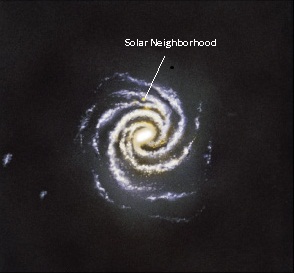
The above diagram is a schematic of the Milky Way Galaxy. The yellow
blob located
on the bottom edge of a sprial arm that is above the center of the
galaxy represents
the Solar Neighborhood. Shown on the left are two dwarf satellite
galaxies of our
galaxy, known as the Magellanic Clouds
4. The Local Group: A gravitationally bound cluster of about 50 or so galaxies, including our galaxy.
5. The Local Supercluster:A cluster of many smaller clusters of galaxies, including our local group.
6. Supercluster Walls: Arrangements of superclusters making up the boundaries of large voids in space.
7. The Universe
or Cosmos:
The largest scale of physical reality, which consists of
other clusters
and superclusters of galaxies extending, in a frothy like distribution,
to the limit of visibility.
The
above structure of the universe results from gravity. That is, the structure
of the
universe
is what it is because of the nature of gravity or law of gravity. If the
law of
gravity
were different, then the universe would have a different structure
than the
one
we observe.
The photo below is of a normal spiral galaxy much like our own. Notice
the dust clouds
in the disk of the spiral arms. Where did the dust come
from and why is it important?
(Photo courtesy of NASA)
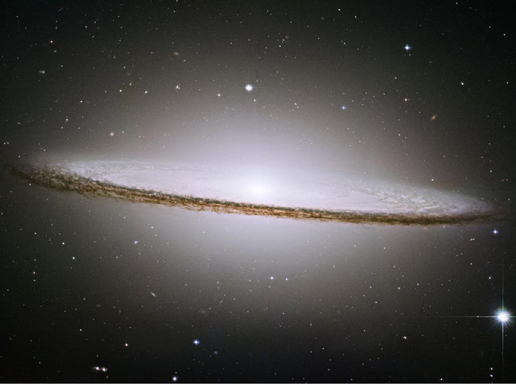
A schematic 3D representation of the Local Group is shown above.
Surveys of galaxies on large scales have revealed that the clusters
of galaxies
are distributed in a frothy pattern, forming large walls surrounding
various
voids, as shown below:

In 1926, Edwin Hubble published a paper showing how he was able to compute
the
distance of the Andromeda galaxy by studying variable stars that he
found in that galaxy.
This was the first time anyone had measured the distance to another
galaxy and, in
fact, this proved that there were other galaxies in the universe in
addition to ours.
In 1929, Hubble published another paper concluding that the universe
was expanding.
He reached this conclusion by studying the motions and distances
of many galaxies.
In 1998, a team of astronomers discovered that the expansion
of the universe is
accelerating. Why this is so is not completely known.
Origin of the Universe
In 1931, Georges
Lemaitre, a Belgian Roman Catholic priest and professor of physics
at the University of Leuven, proposed what is now called the
"Big Bang" Theory for the
origin of the universe. That is, the universe expanded from what
was initially a
microscopically small, dense state, to what we observe today.
In 1940, Geogre Gamow,
a Ukranian born nuclear physicist, further developed the physics
of this early state of
the universe, called the Primordial Atom.
So what is the origin of physical reality?
C. THE MOTIONS OF THE EARTH
Our observations
of the universe are made from a moving observatory, the
Earth. The
motions of the Earth affect
what we see in the sky. These motions are:
1. Rotation
In astronomy, rotation is always motion of a body around
an imaginary axis
passing through that body.
Every point on the Earth's surface rotates through an angle of 360o
in 24 hours around
the Earth's axis. This defines the length of a period of time we call the
day.
The angular rate of rotation of the Earth is 3600/24 hr. = 150/hr.
As a consequence of the Earth's rotation, every object in the sky rises
on the eastern
horizon moves across the sky and sets on the western horizon. In
so doiing, objects
are said to trace out what are called "diurnal circles."
2. Revolution
In astronomy, revolution is always the orbital motion of a
body around a point
called the center of gravity or barycenter. The Earth revolves
in orbit around the
Sun once in 365.2563 days or one sidereal year.
3.
Precession
4. Terrestrial-Lunar Motion
The revolution of the Earth and Moon around a common center of gravity.
The Earth and Moon gravitationally interact in such a way that their centers
individually
revolve 360o around their common center of gravity (baeycenter)
in a time of 27.33
days or 1 sidereal month. This center of gravity is inside the Earth but
it is closer to
the surface of the Earth than it is to the center of the Earth.
The distance of the
center of the Moon from the Barycenter is 80 times greater than distance
of the
center of the Earth from the barycenter or about 384,000 km.
D. SOME DEFINITIONS
Planet: a
type
of
body moving in orbit around a star.
The word "type" here is important
because planets are
not the only kind of bodies orbiting a star. Planets usually do not
exist
in space by themselves,
they are only found orbiting a star. There may be some runaways.
Star: a very
hot, usually gaseous body that generates, or at one time did generate
energy by thermonuclear
fusion of hydrogen into helium. Stars are always more
massive than planets.
Mass: the amount
of matter in a body. Units of mass are grams or kilograms.
Some
examples of relative mass are:
ME= 80 ML
The subscripts S, E, and "L" stand for the Sun, Earth, and Luna, the Moon.
Do not confuse size with mass.
For example, the radius of
the Earth is approximately 6,000 km.
Examples of some relative
sizes are:
RS= 107RE
RE= 4RL
Density is an
expression of the amount of mass contained in a unit volume.
For example, the density of water is 1 gram per cubic centimeter (abbreviated
as
gm/cm3). The average
rock on the Earth's surface has a density of about 3 gm/cm3.
Satellite: an
object or body moving in orbit around a more massive object.
For example, planets and comets are satellites of the Sun. The Moon is
a satellite of
the Earth.
Weight is an
expression of the force of gravity between an object and another body,
such as between you and the Earth.
Why is the weight of one
person different than another? It is because they have different
masses. Your weight
would be different if you were on the Moon, but your mass would be
the same unless you went
on a diet.
E. FUNDAMENTAL FORCES
Only four
forces are needed to explain all the interactions that occur in the physical
world. Thesse
are called the fundamental forces. What is a force?
Force: something that produces an acceleration or change in velocity of an object.
Only unbalanced or net forces
produce accelerations. If an object is observed to be
ccelerating, then we conclude
a net force is acting on the body. Forces are also said
to produce interactions.
Acceleration is the time rate of change of velocity.
Velocity is the speed of an object in a specified direction..
The four fundamental forces of the universe aew.
1. Gravity is a force of attraction that exists between
any two physical objects.
The nature of gravity dictates the large scale or macroscopic structure
of the
physical universe.
2. Electromagnetism is the force that dictates the structure
and workings of the
atom (arrangement of the electrons around the nucleus) and
the interaction
of radiation with matter.
3. Nuclear or Strong Force determines the internal structure and
workings of the
atomic nucleus, including all nuclear reactions.
4. The Weak Interaction is the force involved in subatomic
particle interactions,
such as radioactive decay.
There may actually be a 5th
force in order to account for the acceleration in the expansion
of the universe. This
may be anti-gravity, but this is conjectural at this time.
F. NEWTON'S LAWS OF MOTION (Also read in textbook)
Newton's 1st Law of Motion (Law of Inertia):
An object's motion
remains constant
unless an unbalanced force acts on it.
Newton's 2nd Law of Motion: When there is a net or unbalanced
force acting on
a body, that body begins to accelerate. For a given force, the smaller
the mass of a
body, the larger its acceleration. This is Newton's 2nd Law
of Motion., that is
a = F/m, where a is the acceleration, F is the net force, and m is the
mass on which
the force is acting.
Newton's 3rd Law of Motion: When any two bodies
interact, they do so in such
a way that they exert equal but oppositely directed forces on one another.
These laws are valid regardless of what force is involved. Let us consider gravity.
When any two bodies interact gravitationally with one another, be they
two stars,
or a star and one of its satellites, they do so in accordance with Newton's
Laws
of Motion as follows:
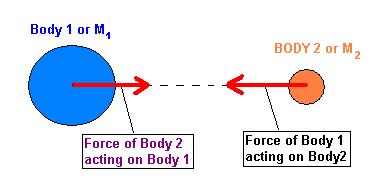
To prove this for gravity, Newton imagined every little portion of the
Earth pulled on
an apple as shown in the diagram below. To calculate the net result
of all these
forces, Newton invented the form of mathematics that we now call
integral calculus.
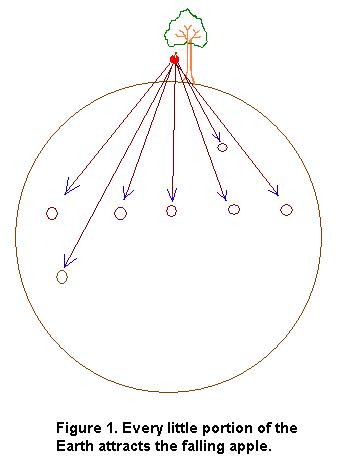
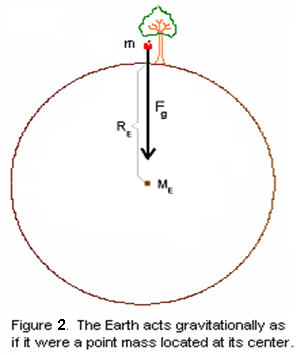
3.
The net force causes the body it acts on to speed up or accelerate
in the direction
of the force. The greater the mass of the body, the less it accelerates
and the
slower it moves. This is the meaning of Newton's 2nd law of motion.
4.
If the two interacting bodies are very different in mass, the less massive
body will
accelerate much more than the more massive body and after a certain time
has
passed, the less body will be moving much faster than the more
massive body.
Remember, items 1 through 4 above are valid regardless of what force is involved.
The law of gravity was invented by Sir Isaac Newton, circa 1671. This law
describes the
gravitational attraction
that exists between any two objects in the universe. In other words,
the law of gravity is valid
everywhere. For this reason, it is often referred to as the
universal
law of gravity.
More specifically,
Newton came to the conclusion that the strength of this attraction
or force is:
1. Directly proportional
to the product (Mm) of the individual masses of the two interacting
bodies M and m. We may also label the masses as m1 and
m2.
2. Inversely
proportional to the square of the mutual separation (dist. apart) of the
two bodies.
That is, the force depends on 1/ r2, where r is the distance
from center to center of the
bodies.
Newton's Law of gravity can be written as an equation that expresses how
the amount of
force can be calculated
in terms of the masses of two interacting bodies and their distance
apart; no other factors
are involved.
Imagine
a scenario where 2 bodies each had some initial velocity before they get
close
enough for the gravitational
attraction between them to become significant. Hence, they
initially move along a straight
line at constant speed.
When they get sufficiently
close to one another, the gravitational forces they would exert
on one another would produce
a change in their velocities thereby changing the
trajectories of the bodies.
They would begin to move along a curved trajectory or path.
If the
initial conditions are just right, the two bodies would begin to revolve
around a
barycenter, or center of
gravity, with closed trajectories, that is, orbits. The distance
of
the center of the less
massive body from the barycenter would be larger than the distance
of the center of the more
massive body from the barycenter. The ratio of these distances
would be the inverse of
their mass ratio.
The
mass ratio is simply the mass of the more massive body divided by
the mass
of
the less massive body. This number tells one how much farther the
less massive
body
is from the barycenter.
For example, the Earth
is 80 times more massive than the Moon. Hence, the distance of
the center of the
Moon from the barycenter is 80 times greater than the distance of the
center of the Earth from
this barycenter. The result for the Earth-Moon system is that
the common barycenter is
inside the Earth at about 1400 Km below the surface, or 4600
Km from the center of the
Earth.
If two
bodies had identical masses, their mutual barycenter would be midway between
their centers. Where would
the barycenter be for a system in which on of the interacting
bodies was twice the mass
of the other?
Newton
also developed the idea that something could be put into orbit around the
Earth. If one were to fire
a missile with just the right velocity, it would fall towards the
center of the Earth in such
a way that it would be moving in a closed path or circular orbit.
If the initial speed were
slightly larger, the missile would go into an elliptical orbit. If
the
speed were too small, the
missile would fall back onto the ground. If the initial speeed were
too great, the missile would
escape from the Earth. See the diagram below.
End Chapter 1